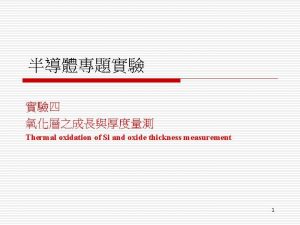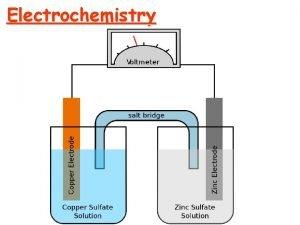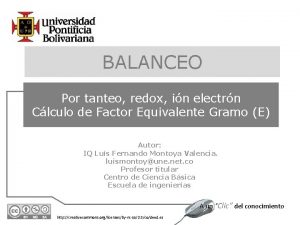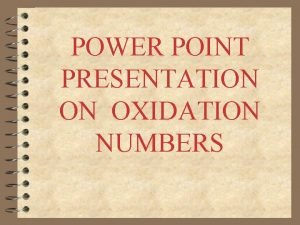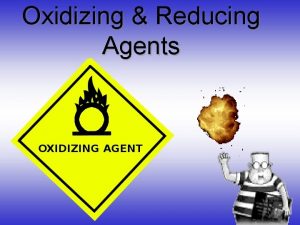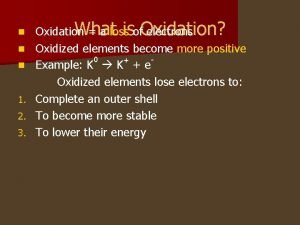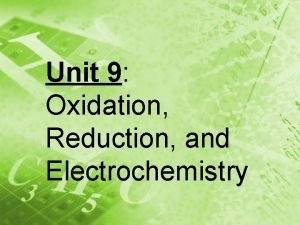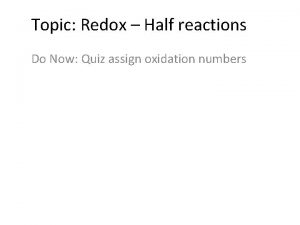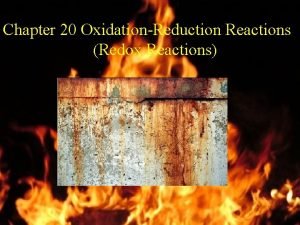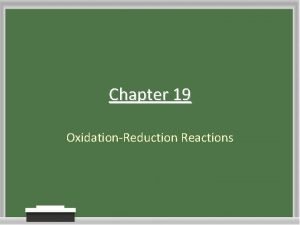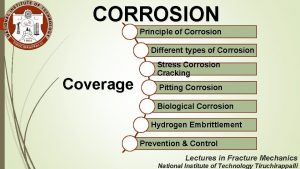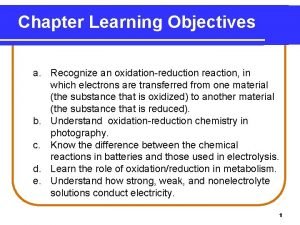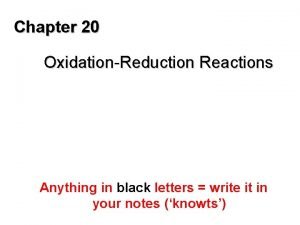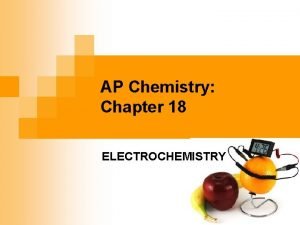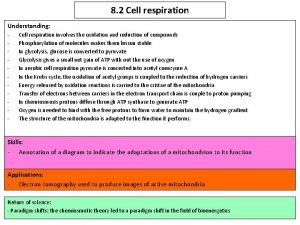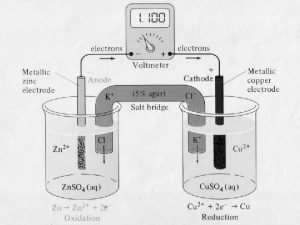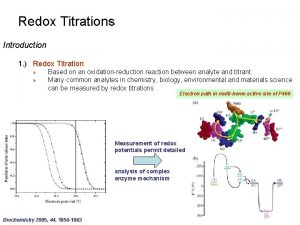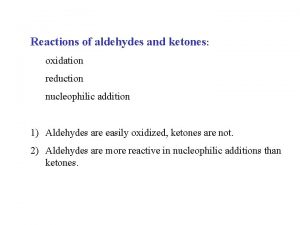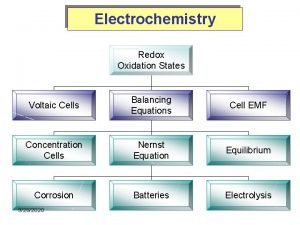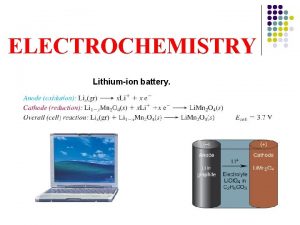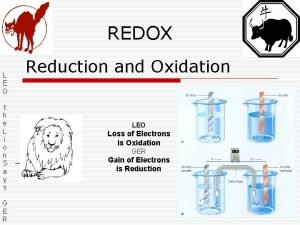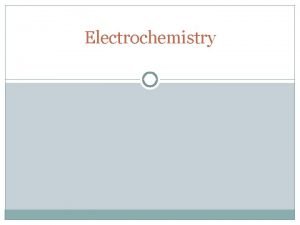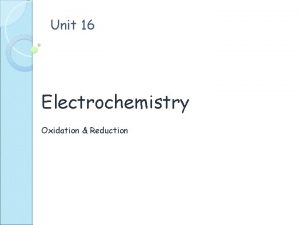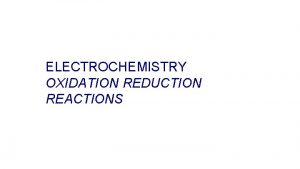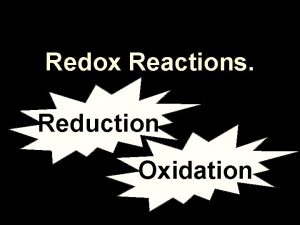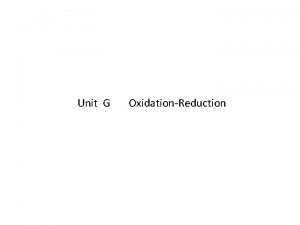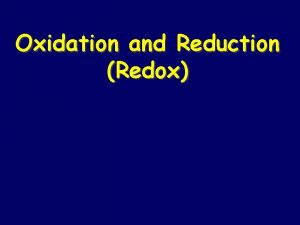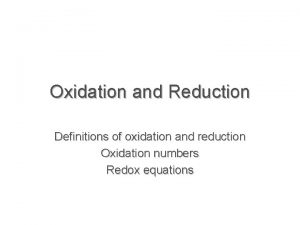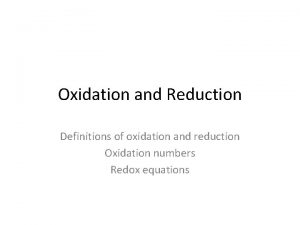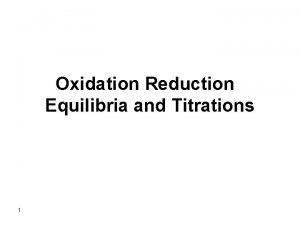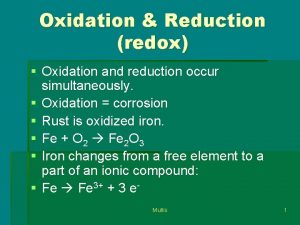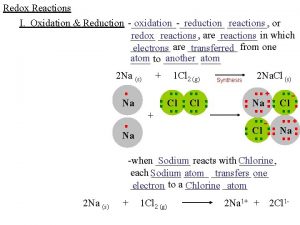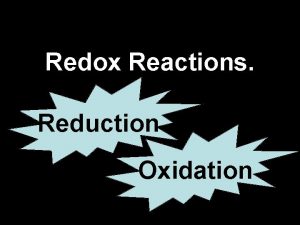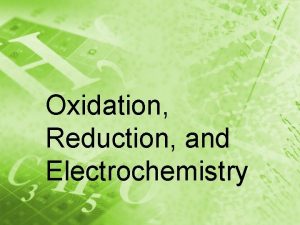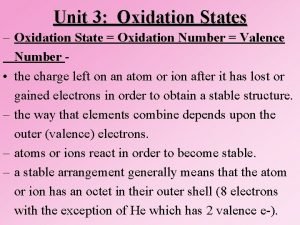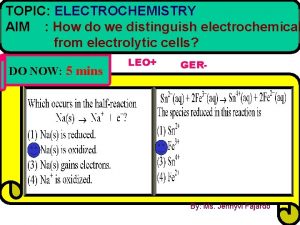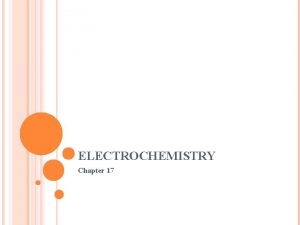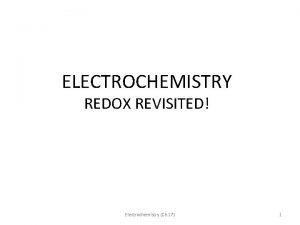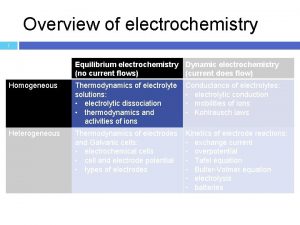Unit 9 Oxidation Reduction and Electrochemistry TOPIC 1









































- Slides: 41

Unit 9: Oxidation, Reduction, and Electrochemistry

TOPIC 1: Half Reactions Objective: Determine oxidation numbers for elements in a compound, identify the oxidized and reduced species, write half reaction, and balance ionic reactions

I. What is Electrochemistry? • The study of electricity and how it relates to chemistry charges (e-) • Electricity is caused by the movement of _______ • We will be focusing on how energy is produced/converted by electrochemical cells: Produces electrical energy • Voltaic -________________ (ie. – battery) • Electrolytic - Uses electrical energy to _____________ produce a chemical reaction (ie. – electroplating)

I. What is Electrochemistry? • Within these cells there are ___________ chemical reactions that involves a __________ transfer of electrons redox reactions • These chemical reactions are called _________ gain of e • Reduction: _________ and the ion becomes ___________ more negatively charged • Oxidation: ___________ and the ion loss of ebecomes ___________ more positively charged -

I. What is Electrochemistry? • Way to remember it: “LEO says GER” LOSS of Electrons is OXIDATION GAIN of Electrons is REDUCTION

II. Assigning Oxidation Numbers • The first step in determining which species was oxidized and which was reduced is knowing what the charge of each species starts at and ends at, so you can determine whether electrons were lost or gained. Why is that important? • Ever put a battery in backwards? It doesn’t work! Circuits are designed to only let electrons through ONE way. It is possible to destroy an electronic device by putting the battery in backwards. We need to know which end is – (the end that loses electrons, oxidation) and which end is + (the end that gains electrons, reduction), so we need to know how to find the charges (oxidation numbers) of the species involved!

II. Assigning Oxidation Numbers • Rules for assigning oxidation number (REVIEW): 1. Each uncombined element has an oxidation number zero of _____ • Example: 2 Na + Cl 2 2 Na. Cl _________ has an oxidation number (charge) of Na and Cl 2 _______ zero 2. If an element has only ______ oxidation number one (charge) listed on the __________, then that periodic table is its oxidation number + 1 • Examples: Na has a charge of _____ Ca has a charge of _____ + 2 Al has a charge of _____ + 3 - 2 O has a charge of _____

II. Assigning Oxidation Numbers • Rules for assigning oxidation number (REVIEW): 3. If a nonmetal atom is the negative ion in an ionic first charge compound, then the___________ listed is its oxidation number • Examples: - 1 • In Na. Cl, Cl is the negative ion, so its charge is _____ - 3 • In Li 3 N, N is the negative ion, so its charge is ______ - 2 • In Zn. S, S is the negative ion, so its charge is _____

II. Assigning Oxidation Numbers • Rules for assigning oxidation number (REVIEW): ZERO 4. The sum of all charges in an compound equals _____ Examples: Show that the sum of the charges equals zero for the following compounds: Na. Cl 1(+1) + 1(-1) = 0 Li 3 N 3(+1) + 1(-3) = 0 Mg. Cl 2 1(+2) + 2(-1) = 0

II. Assigning Oxidation Numbers • Rules for assigning oxidation number (REVIEW): 5. The sum of all charges in a polyatomic ion equals ______________ the net charge listed on Table E Examples: Identify the charges for the following PAI: SO 4 - 2 - 1 NO 3 - 2 S 2 O 3 SCN - 1

II. Assigning Oxidation Numbers • Rules for assigning oxidation number (REVIEW): 6. If an element has more than one charge listed, use the other charges to figure it out Zn. SO 4 Fe(NO 3)2 PO 4 -3 1(+2) + X + 4(-2) = 0 (+2) + 2(X) + 6(-2) = 0 X + 4(-2) = -3 2 + X – 8 = 0 2 + X – 12 = 0 S = X = +6 N = X = + 5 P = X = +5

III. Identifying the Oxidized and Reduced SPECIES • If the charge becomes more positive going from left to OXIDIZED right, the species is _____ and ________ LOSES ELECTRONS (OX # ↑) • If the charge becomes more negative going from left to right, the species is _____ and _________ REDUCED GAINS ELECTRONS (OX # ↓) ION THAT DOES NOT • Spectator Ions _________________ CHANGE CHARGE

III. Identifying the Oxidized and Reduced SPECIES • For the following reactions, identify the species (symbol AND charge) that undergoes oxidation, reduction or is the spectator ion (if available): 0 0 +1 -1 2 Na + Cl 2 2 Na. Cl o Na Oxidized ______ o Cl NONE 2 Reduced _____ Spectator Ion ______

III. Identifying the Oxidized and Reduced SPECIES +2 -2 0 0 2 Ca. O 2 Ca + O 2 -2 +2 O Ca NONE Oxidized _______ Reduced ____ Spectator Ion _______ 0 +3 -1 +2 -1 0 3 Mg + 2 Au(NO 3)3 3 Mg(NO 3)2 + 2 Au 0 +3 Mg NO Au 3 Oxidized _______ Reduced _____ Spectator Ion ____

IV. Identifying the Oxidized and Reduced AGENTS reduction • Reducing Agent: causes ______ (or is _______) oxidized oxidation reduced • Oxidizing Agent: causes ______ (or is _______) **AGENTS ALWAYS COME FROM THE REACTANT SIDE** • For the following reactions, identify the oxidizing and reducing agent and spectator ion (if possible) 0 0 +1 -1 2 Li + F 2 2 Li. F ox. red. F 20 Reducing Agent _____ Li 0 • Oxidizing Agent _____ NONE Spectator Ion ______

IV. Identifying the Oxidized and Reduced AGENTS +2 -2 0 0 2 Mg. O 2 Mg + O 2 red. ox. Mg Oxidizing Agent_______ +2 0 O Reducing Agent _______ NONE Spectator Ion ______ +2 -2 -1 +2 -1 Ba + Sr(OH)2 Ba(OH)2 + Sr ox. red. Sr+2 • Oxidizing Agent_______ 0 Ba 0 Reducing Agent _______ Spectator Ion ______ OH-1

V. Identifying Redox Reactions • (Most) Redox reactions have a free element on one side of a reaction and the same element bonded to something else on the other side • Examples: • 2 H 2 + O 2 --> 2 H 2 O Free element ---> Bonded element • 2 KCl. O 3 --> 2 KCl +3 O 2 Bonded oxygen ----> Free oxygen

CHECK FOR UNDERSTANDING • Which equation represents an oxidation reduction reaction? (1) CH 4 + 2 O 2 ==> CO 2 + 2 H 2 O (2) H 2 SO 4 + Ca(OH)2 ==> Ca. SO 4 + 2 H 2 O (3) Mg. Cr. O 4 + Ba. Cl 2 ==> Mg. Cl 2 + Ba. Cr. O 4 (4) Zn(NO 3)2 + Na 2 CO 3 � ==> 2 Na. NO 3 + Zn. CO 3 • Which balanced equation represents a redox reaction? (1) Ag. NO 3 + Na. Cl ==>Ag. Cl + Na. NO 3 (2) Ba. Cl 2 + K 2 CO 3 � ==> Ba. CO 3 + 2 KCl (3) Cu. O + CO ==> Cu + CO 2 (4) HCl + KOH � ==> KCl + H 2 O • Conclusion Redox reactions can be combustion, synthesis, decomposition, and single replacement reactions, but NOT double replacements) If there is a change in oxidation # for a particular atom, then it is a redox reaction.

VI. Half-Reactions • A redox reaction may be split into 2 half-reactions, one for oxidation reduction ________ and the other for __________ • Oxidation: X 0 X+ + e- (e- on the _______ side product lost shows that it has been _______) X- X 0 + e • Reduction: X+ + e- X 0 + e - X reactant (e- on the ______ side gained shows that it has been_______) IN GENERAL: e- go on the more positive side

VI. Half-Reactions • For the following reactions, write the half-reactions: +2 -2 0 0 Ca. S Ca + S red ox Oxidation Reduction S -2 S 0 + 2 e- Ca +2 + 2 e- Ca 0

VI. Half-Reactions • For the following reactions, write the half-reactions: 0 +2 -1 0 Mg + Cu. SO 4 Mg. SO 4 + Cu ox Oxidation Mg 0 Mg+2 + 2 e- red Reduction Cu +2 + 2 e- Cu 0

VI. Half-Reactions • For the following reactions, write the half-reactions: 0 0 +1 -2 2 H 2 + O 2 2 H 2 O ox red Oxidation H 2 0 2 H+1 + 2 e- Reduction O 2 0 + 4 e- 2 O -2

VI. Half-Reactions • For the following reactions, write the half-reactions: 0 +1 -1 ox red +1 -1 0 2 Na + 2 HOH 2 Na. OH + H 2 Oxidation Na 0 Na+1 + 1 e- Reduction 2 H + + 2 e- H 20

VII. Balancing Ionic Redox Reactions • A chemical reaction MUST HAVE: MASS (same # of atoms/ions on both 1. Conservation of _________ sides) CHARGE 2. Conservation of _________ • Ionic reaction: reaction with the spectator ions removed • Balancing Ionic Redox Reactions: Li + Zn +2 Li +1 + Zn • The reaction may looked balanced, because there is MASS conservation of __________, but the reaction CHARGE does not show a conservation of _______

VII. Balancing Ionic Redox Reactions • Examples: Balance the following ionic redox reactions 1. Determine how much charge changes for each species 2. Multiply each species by how much the other species changes charge +2 _____ Li +1 + _____ Zn 2 1 ____Li + _____ Zn 2 (0) + 1(+2) = 2(+1) + 1(0) +2 = +2 Mass and charge conserved

VII. Balancing Ionic Redox Reactions • Examples: Balance the following ionic redox reactions 1. Determine how much charge changes for each species 2. Multiply each species by how much the other species changes charge + + _____ Fe +3 _____ Cu +2 + _____ Fe 1 3 _____Cu 3 (+1) + 1(+3) = 3(+2) + 1(0) +6 = +6 Mass and charge conserved

VII. Balancing Ionic Redox Reactions • Examples: Balance the following ionic redox reactions 1. Determine how much charge changes for each species 2. Multiply each species by how much the other species changes charge + _____ Al 3 2 6 2 +3 + _____ H _____Al + _____ H 2 3 (0) + 6(+1) = 2(+3) + 3(0) +6 = +6 Mass and charge conserved

TOPIC 2: Electrochemistry Objective: Predict which redox reactions will be spontaneous based on their position on the activity series table, identify the parts of a voltaic and electrolytic cell and describe their purpose, explain why the changes in concentration in each half cell are occurring as the reaction proceeds, and design a voltaic and electrolytic cell of your own.

VIII. Table J (Revisited) TOP • The metal closer to the _____ of Table J are MORE REACTIVE __________ and, therefore, more likely to be OXIDIZED (lose e-) _________. The nonmetals that are more reactive REDUCED (gain e-) are more likely to be ___________ METAL SPONTANEOUSLY • Any ______ on Table J will react ________ with a ___________ that is METAL ION BELOW IT ___________ • This means that the metal with a charge must BELOW NEUTRAL be________ the __________ metal for there to be a reaction • Activity Series ANIMATION

VIII. Table J (Revisited) • Example: According to Table J, which of the following will react spontaneously? X + H+ H 2 + X+ A) Pb +2 B) Sn+2 C) Fe D) H 2 • Example: Which of the following will replace Ni+2 in the compound Ni(NO 3)2? A) Sn +2 B) Pb+2 C) Sn D) Cr • Example: Which atom/ion pair will Co oxidize spontaneously under standard conditions? A) Co + Fe+2 B) Co + Pb+2 C) Co + Cu D) Co + Cr+3

IX. Spontaneous Reactions on Voltaic Cells • • Voltaic Cell - a redox reaction whose two half-reactions are carried out separately, and the electrons given off by the oxidation half-reaction are used to power a device, and then given to the reduction half-reaction. ALSO CALLED A BATTERY (9 v) OR CELL (AAA, C, D) Voltaic Cell Animation and another set of animations: Complete Cell, Anode, Cathode, Salt Bridge • How a Voltaic Wet Cell Works: CHEMICAL ELECTRICAL • Converts _______ energy to _______ energy SPONTANEOUS REDOX REACTION by the use of a ________________ ELECTRONS • _________ move from the metal that is OXIDIZED REDUCED ______ to the metal that is _______ ANODE CATHODE • Flow of electrons: ________________

IX. Spontaneous Reactions on Voltaic Cells • • Voltaic Cell - a redox reaction whose two half-reactions are carried out separately, and the electrons given off by the oxidation half-reaction are used to power a device, and then given to the reduction half-reaction. ALSO CALLED A BATTERY (9 v) OR CELL (AAA, C, D) Voltaic Cell Animation and another set of animations: Complete Cell, Anode, Cathode, Salt Bridge

IX. Spontaneous Reactions on Voltaic Cells • • • • Parts of a Voltaic Wet Cell: Electrode: A PIECE OF METAL WHERE OX. OR RED. OCCURS Anode: ELECTRODE WHERE OXIDITION OCCURS (SIZE ↓ ) Cathode: ELECTRODE WHERE REDUCTION OCCURS (SIZE ↑ ) • REMEMBER: “RED CAT and AN OX” REDUCTION OCCURS ON CATHODE ANODE HAS OXIDATION

IX. Spontaneous Reactions on Voltaic Cells • Salt Bridge: + ions from bridge move into cathode half cell -- ions from bridge move into anode half cell Ions from the salt bridge flow to the solutions completing the circuit Keeps the overall charge neutral in the half cells • External Circuit: WIRE THAT CONDUCTS THE e-

X. Nonspontaneous Reactions on Electrolytic Cells • Electrolytic Cell Animation

X. Nonspontaneous Reactions on Electrolytic Cells • Parts of an Electrolytic Cell: • • • Anode: Metal that is used to plate an object (+) Cathode Metal that is being plated (--) Battery: Produces energy to force nonspontaneous reaction to occur Electrolyte: Allow ions to flow between electrodes Flow of electrons: e – start at anode and move toward the object being plated

X. Nonspontaneous Reactions on Electrolytic Cells • Parts of a Electrolytic Cell: nonspontaneous • Uses a ________ redox reaction (the will NOT reaction _______ occur on its own) electricity force a chemical reaction to • Uses ______ to__________ occur electrolysis • This process is called ____________ • Used for: 1) electroplating 2) Isolation of an element in a compound (Na. Cl Na+Cl 2) 3) Purification of an element

X. Nonspontaneous Reactions on Electrolytic Cells • Electroplating (see electroplating video)

X. Nonspontaneous Reactions on Electrolytic Cells • The Car Battery (or rechargeable batteries) use both types of cells • Spontaneous Reaction to start the car • Nonspontaneous Reaction to charge the battery VIDEO

XI. Similarities and Differences Between Voltaic and Electrolytic Cells • Similarities • “AN OX and RED CAT” • e – flow from anode to cathode • (+) ions flow toward the cathode, (--) ions flow toward the anode • Anode gets smaller, cathode gets larger

XI. Differences Between Voltaic and Electrolytic Cells Voltaic Electrolytic requires a battery is an electric cell _____________________________ negative Anode is __________ positive Cathode is ____________________ positive negative USES PRODUCES __________ electricity SPONTANEOUS REACTION NONSPONTANEOUS __________________ REACTION ½ Reactions are for… Two different elements (two different solutions) ½ Reactions are for… The same element (one solution both electrodes)
 Kh oxidation number
Kh oxidation number Topic 9 oxidation-reduction
Topic 9 oxidation-reduction Half equations redox
Half equations redox Oxide thickness color chart
Oxide thickness color chart Equilibrium constant formula electrochemistry
Equilibrium constant formula electrochemistry Redox reactions
Redox reactions Balanceo por redox
Balanceo por redox Oxidation examples
Oxidation examples Differentiate between oxidation and reduction
Differentiate between oxidation and reduction What is reduction
What is reduction Which identifies an oxidation-reduction reaction?
Which identifies an oxidation-reduction reaction? Oxidation reduction quiz
Oxidation reduction quiz Topic 19
Topic 19 Leo ger
Leo ger How to write half reactions
How to write half reactions Chapter 19 redox reactions study guide answers
Chapter 19 redox reactions study guide answers Chapter 20 oxidation-reduction reactions answer key
Chapter 20 oxidation-reduction reactions answer key Chemical texture services
Chemical texture services How to write reduction half reactions
How to write reduction half reactions Leo and ger
Leo and ger Oxidation corrosion
Oxidation corrosion Oxidation–reduction reactions
Oxidation–reduction reactions Leo ger oxidation reduction
Leo ger oxidation reduction Leo the lion says ger
Leo the lion says ger Leo the lion goes ger
Leo the lion goes ger Oxidation reduction memory tricks
Oxidation reduction memory tricks Oxidation reduction
Oxidation reduction Red cat oxidation reduction
Red cat oxidation reduction Galvanic cell cathode
Galvanic cell cathode Oxidation reduction titration
Oxidation reduction titration What is a redox reaction
What is a redox reaction Self oxidation reduction reaction of aldehyde
Self oxidation reduction reaction of aldehyde Electrochemistry balancing equations calculator
Electrochemistry balancing equations calculator Basic corrosion
Basic corrosion Leo ger
Leo ger Pee writing strategy
Pee writing strategy Narrow
Narrow Unit 10, unit 10 review tests, unit 10 general test
Unit 10, unit 10 review tests, unit 10 general test Electrochemistry tutorial
Electrochemistry tutorial Write about the hittorf rule
Write about the hittorf rule Electrochemistry tutorial
Electrochemistry tutorial Ap chemistry chapter 18 electrochemistry test
Ap chemistry chapter 18 electrochemistry test



